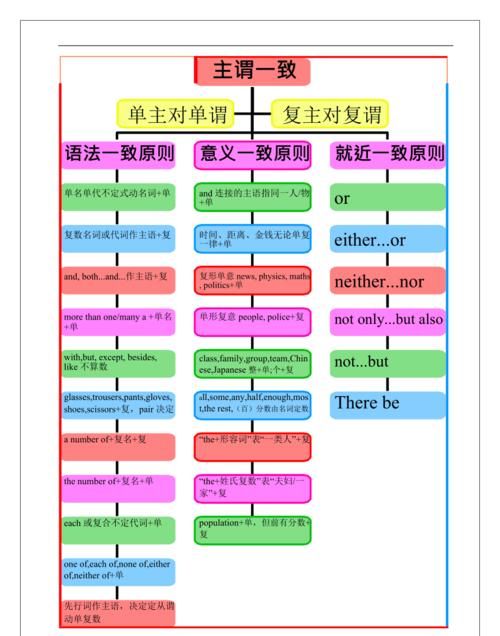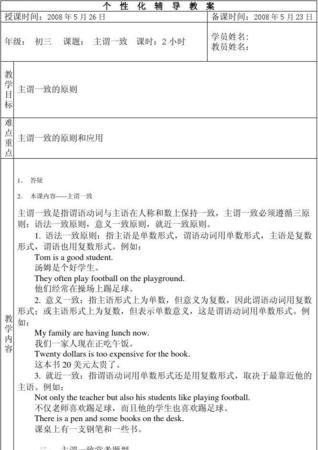本文目录
主谓一致应遵循哪些原则并举例
主谓一致的三个原则是语法一致原则、意义一致原则和就近一致原则,主谓一致即谓语动词在人称和数上要和主语保持一致,主谓一致包括语法一致、意义一致和就近一致,语法一致即谓语动词在单复数形式上要和主语保持一致,意义一致就是谓语动词要和主语意义上的单复数保持一致,就近一致就是谓语动词要和靠近它的主语部分保持一致。

主谓一致的语法归纳
主谓一致指“人称”和“数”方面的一致关系。
1
并列结构作主语时谓语用复数
Reading
and
writing
are
very
important.
2
主谓一致中的(就近原则)
当there
be
句型的主语是一系列事物时,谓语应与最邻近的主语保持一致.
There
is
a
pen,a
knife
and
several
books
on
the
desk..
There
are
twenty
boy-students
and
twenty-three
girl-students
in
the
class.
3
谓语动词与前面的主语一致
(就前原则)
当主语后面跟有with,together
with,like,except,but,no
less
than,as
well
as
等词引起的短语时,谓语动词与前面的主语一致.
The
teacher
together
with
some
students
is
visiting
the
factory.
He
as
well
as
I
wants
to
go
boating.
4
谓语需用单数
1)
代词each和由every,some,no,any等构成的复合代词作主语,或主语中含有each,every,谓语需用单数.
Each
of
us
has
a
tape-recorder.
There
is
something
wrong
with
my
watch.
2)
当主语是一本书或一条格言时,谓语动词常用单数.
The
Arabian
Night
is
a
book
known
to
lovers
of
English.
<一千零一夜>是英语爱好者熟悉的一本好书.
3)
表示金钱,时间.距离.价格或度量衡的复合名词作主语时,通常把这些名词看作一个整体,谓语一般用单数.(用复数也可,意思不变.)
Three
weeks
was
allowed
for
making
the
necessary
preparations.
Ten
yuan
is
enough.

主谓一致专练及详解
在英语句子里,谓语受主语支配,其动词必须和主语在人称和数上保持一致,这就叫主谓一致。寻其规律,大致可归纳为三个原则,即语法一致、逻辑意义一致和就近一致原则。
一、语法一致原则
语法上一致就是谓语动词和主语在单、复数形式上保持一致。
1. 以单数名词或代词、动词不定式短语、动名词短语或从句作主语时,谓语动词一般用单数形式;主语为复数时,谓语动词用复数形式。如:His father is working on the farm. / To study English well is not easy. / What he said is very important for us all. / The children were in the classroom two hours ago. / Reading in the sun is bad for your eyes.
注意:由what引导的主语从句,后面的谓语动词多数情况用单数形式,但若表语是复数或what从句是一个带有复数意义的并列结构时,主句的谓语动词用复数形式。如:What I bought were three English books. / What I say and do is (are) helpful to you.
2. 由连接词and或both …… and连接起来的合成主语后面,要用复数形式的谓语动词。如:Lucy and Lily are twins. / She and I are classmates. / The boy and the girl were surprised when they heard the news. / Both she and he are Young Pioneers.
注意:(1)若and所连接的两个词是指同一个人或物时,它后面的谓语动词就应用单数形式。如:The writer and artist has come. (2)由and连接的并列单数主语前如果分别有no, each, every more than a (an) , many a (an)修饰时,其谓语动词要用单数形式。如:Every student and every teacher was in the room. / No boy and no girl likes it.
3. 主语为单数名词或代词,尽管后面跟有with, together with, except, but, like, as well as, rather than, more than, no less than, besides, including等引起的短语,谓语动词仍用单数形式;若主语为复数,谓语用复数形式。如:Mr. Green, together with his wife and children, has come to China. / Nobody but Jim and Mike was on the playground. / She, like you and Tom, is very tall.
4. either, neither, each, every 或no +单数名词和由some, any, no, every构成的复合不定代词,都作单数看待。如:Each of us has a new book. / Everything around us is matter.
注意:(1)在口语中当either或neither后跟有“of+复数名词(或代词)”作主语时,其谓语动词也可用复数。如:Neither of the texts is (are) interesting. (2)若none of后面的名词是不可数名词,它的谓语动词就要用单数;若它后面的名词是复数,它的谓语动词用单数或复数都可以。如:None of us has (have) been to America.
5. 在定语从句时,关系代词that, who, which等作主语时,其谓语动词的数应与句中先行词的数一致。如:He is one of my friends who are working hard. / He is the only one of my friends who is working hard.
6. 如果集体名词指的是整个集体,它的谓语动词用单数;如果它指集体的成员,其谓语动词就用复数形式。这些词有family, class, crowd, committee, population, audience等。如:Class Four is on the third floor. / Class Four are unable to agree upon a monitor.
注意:people, police, cattle等名词一般都用作复数。如:The police are looking for the lost child.
7. 由“a lot of, lots of, plenty of, the rest of, the majority of + 名词”构成的短语以及由“分数或百分数+名词”构成的短语作主语,其谓语动词的数要根据短语中后面名词的数而定。如:There are a lot of people in the classroom. / The rest of the lecture is wonderful. / 50% of the students in our class are girls.
注意:a number of“许多”,作定语修饰复数名词,谓语用复数;the number of“……的数量”,主语是number,谓语用单数。
8. 在倒装句中,谓语动词的数应与其后的主语一致。如:There comes the bus. / On the wall are many pictures. / Such is the result. / Such are the facts.
二、逻辑意义一致原则
逻辑意义一致就是谓语动词的数必须和主语的意义一致(因有时主语形式为单数,但意义为复数;有时形式为复数,但意义为单数)。
1. what, who, which, any, more, all等代词可以是单数,也可是复数,主要靠意思来决定。如:Which is your bag? / Which are your bags? / All is going well. / All have gone to Beijing.
2. 表示“时间、重量、长度、价值”等的名词的复数作主语时,谓语动词通常用单数形式,这是由于作主语的名词在概念上是一个整体,如:Thirty minutes is enough for the work.
3. 若英语是书名、片名、格言、剧名、报名、国名等的复数形式,其谓语动词通常用单数形式。如:“The Arabian Nights” is an interesting story-book.
4. 表数量的短语“one and a half”后接复数名词作主语时,其谓语动词可用单数形式(也可用复数。如:One and a half apples is (are) left on the table.
5. 算式中表示数目(字)的主语通常作单数看待,其谓语动词采用单数形式。如:Twelve plus eight is twenty. / Fifty-six divided by eight is seven.
6. 一些学科名词是以 –ics 结尾,如:mathematics, politics, physics 以及news, works等,都属于形式上是复数的名词,实际意义为单数名词,它们作主语时,其谓语动词要用单数形式。如:The paper works was built in 1990. / I think physics isn‘t easy to study.
7. trousers, glasses, clothes, shoes, 等词作主语时,谓语用复数,但如果这些名词前有a (the) pair of等量词修饰时,谓语动词用单数。如:My glasses are broken. / The pair of shoes under the bed is his.
8. “定冠词the + 形容词或分词”,表示某一类人时,动词用复数。
三、就近一致原则
在英语句子中,有时谓语动词的人称和数与最近的主语保持一致。
1. 当两个主语由either …… or, neither …… nor, whether …… or ……, not only …… but also连接时,谓语动词和邻近的主语一致。如:Either the teacher or the students are our friends. / Neither they nor he is wholly right. / Is neither he nor they wholly right?
2. there be句型be动词单复数取决于其后的主语。如果其后是由and连接的两个主语,则应与靠近的那个主语保持一致。如:There are two chairs and a desk in the room.
莲山课件 原文地址:***/shti/gaosan/54163.htm

英语主谓一致语法讲解
主谓一致即谓语动词在人称和数上要和主语保持一致,主谓一致包括语法一致、意义一致和就近一致,语法一致即谓语动词在单复数形式上要和主语保持一致,意义一致就是谓语动词要和主语意义上的单复数保持一致,就近一致就是谓语动词要和靠近它的主语部分保持一致。
主谓一致( Subject-Verb Concord )
就其在现代语法中的基本原则而言,通常有三个不同角度的着眼点:1,语法一致 2,意义一致 3,就近原则。
(1)语法一致
主谓一致的原则是指,主语和谓语从语法形式上取得一致:
主语是单数形式,谓语也采取单数形式;主语是复数形式,谓语必须采取复数形式。
例如:
A grammar book helps you learn something about the rules of a language.语法书帮助你学习语言的某些规则。(主语是单数形式,谓语也采取单数形式)
(2)不定式,动名词,以及从句作主语时应看作单数,谓语动词用单数。
例如:
Reading often means learning .读书常意味是学习。
(3)不定代词及each作主语或是修饰主语时应看作单数,谓语动词用单数。
例如:
Neither of my sisters likes sports .我的妹妹中没人喜欢运动。
(4)表示国家,机构,事件,作品等名称的专有名词作主语时应看作单数,谓语动词用单数。
例如:
One Thousand And One Nights tells people lots of mysterious bits of folklore .《一千零一夜》给人们讲了许多神秘的民间传说。
(5)a series of,a kind of,the number of等与名词构成名词短语作主语时看作单数,谓语动词用单数。
例如:
A series of high technology products has been laid out in the exhibition. 一系列高科技产品已在展览上展出。
(6)由some,several,both,few,many,a number of 等词修饰主语,或是由它们自身作主语时应看作复数,谓语动词用复数。
例如:
Both of us are fond of watching football games .我们俩都喜欢看足球赛.
(7)由and连接两个主语时,如指同一人或物,谓语用单数;指不同的人或物,谓语用复数.
On the seashore,some people are playing volleyball and some are lying in the sun. 海边,有些人在打排球,有些人躺着晒太阳.
(8)有些短语,如:a lot of,most of,any of,half of,three fifths of,eighty percent of,some of,none of,the rest of,all of等后接不可数名词,或是单数形式的名词作主语时应看作单数,谓语动词用单数;但如果后接可数名词的复数形式作主语时应看作复数,谓语动词用复数。
例如:
A lot of money in the shop was stolen yesterday when the electricity was suddenly cut off. 昨天突然断电时,那家商店丢失了许多钱.
(9)主语为单数个不定式(短语)、动名词(短语)或从句时,谓语动词一般用单数。
(10)主语为三单,或习惯用作单数名词或不可数名词的词,如:money,information,clothing等,谓语动词用单数。
意义一致(Notional Concord )
这一原则是指,从意义着眼来解决主谓一致问题.有时主语形式上为单数,但意义上却是复数,那么谓语依意义也用复数形式;而有时主语形式上为复数,但意义上却是单数,那么谓语依意义亦用单数形式。
(1)当主语后面接由as well as,as much as,accompanied by,including,in addition to,more than,no less than,rather than,together with等引导的词组时,其谓语动词的形式要依主语的单复数而定。
在这样的句子里,这些词所引导的词组不影响主语自身的单,复数形式,它们在句子里其实是状语.也就是说,我们完全可以将这些词组搬到句首或是放到句末去.从表面上我们也可以看出,它们与主语之间有","隔开。
例如:
Petroleum,along with fuel gas,has recently risen in price.目前石油和燃料煤气的价格上涨了。
(2)表示时间,金钱,距离,体积,重量,面积,数字等词语作主语时,其意义若是指总量应看作单数,谓语动词用单数;但如果其意义是指"有多少数量"则应该看作是复数,那么谓语动词也应该用复数。
例如:
Four weeks are often approximately regarded as one month.人们常大约地将四个星期看成一个月。
(3)形容词前加定冠词即"the + 形容词"作主语时,其意义若是指个人或是抽象概念应看作单数,谓语动词用单数;但如果其意义是指一类人则应该看作是复数,那么谓语动词也应该用复数。
例如:
The young,on the one hand,often think of the old conservative. On the other hand,the old always consider the young inexperience.一方面,青年人常认为老年人保守;另一方面,老年人总是认为青年人没有经验。
(4)当and连接两个并列主语在意义上指同一人,同一物,同一事或者同一概念时,应看作单数,谓语动词用单数.另外,当and 连接两个形容词去修饰一个单数形式的主语时,其实是指两种不同的事物,主语则应该看作是复数,那么谓语动词也应该用复数。
例如:
War and peace is a constant theme in history. 战争与和平是一个历史上的永恒的主题.
(5)集体名词作主语时,谓语动词的数取决于主语的意义:主语表示整体时视为单数,谓语动词用单数;主语表示集体中的个体成员时视为复数,谓语动词用复数.这类集体名词常见的有:
army,audience,cattle,class,club,committee,crowd,family,government,group,majority,minority,part,people,police,public,staff,team等等,其中cattle,people,police一般看成复数形式.
例如:
The family are all fond of football. 那一家人都喜欢足球.
就近原则(Principle of Proximity )
这一原则是指,谓语动词的人称和数常常与最近作主语的词语保持一致.常出现在这类句子中的连词有:or,either… or …,neither… nor …,not only… but also …等.例如:
Either I or they are responsible for the result of the matter.不是我,就是他们要对那件事的结局负责任。
Neither the unkind words nor the unfriendly attitude has caused me any distress.既不是那些不友好的话,也不是那不友好的态度让我沮丧。

扩展资料
1、并列结构作主语时的主谓一致
由and 连接的两个单数名词作主语时,谓语动词一般根据语法一致的原则用复数。
如:
A young man and a girl want to go there.一个青年男子和一个姑娘想去那里。
2、但如果在意义上指同一个人,同一件事或同一个概念时,谓语动词要用单数形式.如:
A needle and thread was found on the floor.在地板上找到了针线(穿了线的针)。
当each ...and each...,every...and every...,no...and no...,many a...and many a...结构作主语时,谓语动词用单数形式.
如:
No man and no animal is to be found on the moon.在月球上没发现人和动物。
3、一个单数名词同时被两个不同的形容词修饰,表示两个不同的概念时,谓语动词一
般用复数.
如:
Ancient and modern history are the subjects we are studying.古代史和现代史是我们目前学习的课程。
但如果表示的是同一概念时应用单数。
如:
The last and most difficult lesson is lesson14.14课是最后一课也是最难的一课。
4、由not only... but also ...,either...or ...,neither... nor...,... or...连接的并列主语,谓语动词通常依就近一致原则决定.
如:
Either the players or the coach is responsible for the defeat.不是运动员就是教练应该对这次比赛的失利负责。
5、当主语由as well as,along with,together with,ratherthan,no less than,but,except,besides,in additionto,like,including等词连接时,其谓语动词的单复数形式通常由前面的词来决定。
如:
An iron and steal works,with some satellite factories. is to be built here.在这里将建立一个钢铁厂和一些卫星厂。
参考资料来源:百度百科-主谓一致
以上就是关于主谓一致的语法总结 ,主谓一致应遵循哪些原则并举例的全部内容,以及主谓一致的语法总结 的相关内容,希望能够帮到您。

